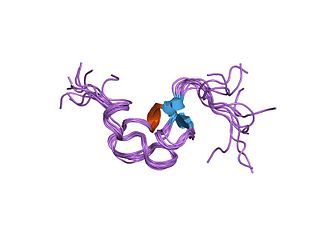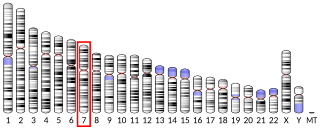The Wnt signaling pathways are a group of signal transduction pathways which begin with proteins that pass signals into a cell through cell surface receptors. The name Wnt is a portmanteau created from the names Wingless and Int-1. Wnt signaling pathways use either nearby cell-cell communication (paracrine) or same-cell communication (autocrine). They are highly evolutionarily conserved in animals, which means they are similar across animal species from fruit flies to humans.

Sclerostin is a protein that in humans is encoded by the SOST gene. It is a secreted glycoprotein with a C-terminal cysteine knot-like (CTCK) domain and sequence similarity to the DAN family of bone morphogenetic protein (BMP) antagonists. Sclerostin is produced primarily by the osteocyte but is also expressed in other tissues, and has anti-anabolic effects on bone formation.

The low-density lipoprotein receptor gene family codes for a class of structurally related cell surface receptors that fulfill diverse biological functions in different organs, tissues, and cell types. The role that is most commonly associated with this evolutionarily ancient family is cholesterol homeostasis. In humans, excess cholesterol in the blood is captured by low-density lipoprotein (LDL) and removed by the liver via endocytosis of the LDL receptor. Recent evidence indicates that the members of the LDL receptor gene family are active in the cell signalling pathways between specialized cells in many, if not all, multicellular organisms.

Catenin beta-1, also known as β-catenin (beta-catenin), is a protein that in humans is encoded by the CTNNB1 gene.

Axin-1 is a protein that in humans is encoded by the AXIN1 gene.

Proto-oncogene Wnt-1, or Proto-oncogene Int-1 homolog is a protein that in humans is encoded by the WNT1 gene.

Frizzled-5(Fz-5) is a protein that in humans is encoded by the FZD5 gene.

Frizzled-1(Fz-1) is a protein that in humans is encoded by the FZD1 gene.

Frizzled-8(Fz-8) is a protein that in humans is encoded by the FZD8 gene.

Frizzled-4(Fz-4) is a protein that in humans is encoded by the FZD4 gene. Fz-4 has also been designated as CD344.

Leucine-rich repeat-containing G-protein coupled receptor 5 (LGR5) also known as G-protein coupled receptor 49 (GPR49) or G-protein coupled receptor 67 (GPR67) is a protein that in humans is encoded by the LGR5 gene. It is a member of GPCR class A receptor proteins. R-spondin proteins are the biological ligands of LGR5. LGR5 is expressed across a diverse range of tissue such as in the muscle, placenta, spinal cord and brain and particularly as a biomarker of adult stem cells in certain tissues.

Dickkopf-related protein 1 is a protein that in humans is encoded by the DKK1 gene.

Low-density lipoprotein receptor-related protein 6 is a protein that in humans is encoded by the LRP6 gene. LRP6 is a key component of the LRP5/LRP6/Frizzled co-receptor group that is involved in canonical Wnt pathway.

Protein Wnt-3a is a protein that in humans is encoded by the WNT3A gene.

Protein Wnt-7a is a protein that in humans is encoded by the WNT7A gene.

Dickkopf-related protein 2 is a protein in the Dickkopf family that in humans is encoded by the DKK2 gene.

Kremen protein 1 is a protein that in humans is encoded by the KREMEN1 gene. Kremen1 is conserved in chordates including amphioxus and most vertebrate species. The protein is a type I transmembrane receptor of ligands Dickkopf1, Dickkopf2, Dickkopf3, Dickkopf4, EpCAM and Rspondin1.

Dishevelled (Dsh) is a family of proteins involved in canonical and non-canonical Wnt signalling pathways. Dsh is a cytoplasmic phosphoprotein that acts directly downstream of frizzled receptors. It takes its name from its initial discovery in flies, where a mutation in the dishevelled gene was observed to cause improper orientation of body and wing hairs. There are vertebrate homologs in zebrafish, Xenopus (Xdsh), mice and humans. Dsh relays complex Wnt signals in tissues and cells, in normal and abnormal contexts. It is thought to interact with the SPATS1 protein when regulating the Wnt Signalling pathway.

Wnt-10a is a protein that in humans is encoded by the WNT10A gene.

Low-density lipoprotein receptor-related protein 4 (LRP-4), also known as multiple epidermal growth factor-like domains 7 (MEGF7), is a protein that in humans is encoded by the LRP4 gene. LRP-4 is a member of the Lipoprotein receptor-related protein family and may be a regulator of Wnt signaling.




















